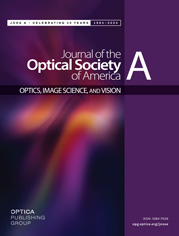
Journal of the Optical Society of America A (JOSA A) Emerging Researcher Best Paper Prize
JOSA A has a rich heritage and stands as an authoritative archival journal. The Editors are particularly pleased to see essential contributions from early-career researchers and expect that their JOSA A papers will form a solid foundation for their future work, as well as that of readers in the community.
With this in mind, the Editors launched the JOSA A Emerging Best Paper Prize. The Prize recognizes one outstanding paper published in the Journal by an emerging researcher each year. Each year’s recipient is selected by a committee of JOSA A Topical Editors and previous Prize winners. Criteria include significance, quality, and presentation. The Prize includes a certificate of recognition, and the winning paper is made openly available at no charge to the author.
To be eligible for the Prize, the first author of the paper must be a student or early-career researcher within five years of earning their highest degree.
Nominations are open in January of each year.
2022 Best Paper Prize Winner

Amala Raj
Indiana University Bloomington
Orbital dynamics at atmospheric pressure in a lensed dual-beam optical trap
The winning paper from 2022 describes how Amala Raj and colleagues developed a theoretical model for optical traps with counter-propagating beams. The committee was particularly impressed by the clarity, balance, and relevance of the paper, and the comprehensive discussion of the results. Read more.
Previous Best Paper Prize Winners

2021
Roi Ronen
Technion—Israel Institute of Technology, Israel
Plankton reconstruction through robust statistical optical tomography
The selection committee was impressed by this article’s successful marriage of experimental optics and applied image-processing, and by the difficulty of the much more general problem of 3D reconstruction from images taken in random orientations and at random scales that it successfully solves using an impressive range of techniques. Read more.

2020
Allie Hexley
University of Oxford, UK
Demonstrating a multi-primary high dynamic range display system for vision experiments
This paper describes a new display system for vision research. Providing simultaneous control over the stimulus’s spatiotemporal properties—luminance, contrast, and spectral content—the new system is a vision-research tool of unprecedented versatility. This paper outlines that there are not just four types of photoreceptors in the eye (three classes of cones and rods), but also a fifth type: the intrinsically photosensitive retinal ganglion cells. In a very strong field, the selection committee judged this winning paper to be outstanding. Read more.

2019
Sarah G. Rody
Chestnut Hill College, USA
The article introduces and examines the concepts of “eigenmirrors” and “eigensurfaces”: the reflection of an eigensurface in its eigenmirror, when viewed from a prescribed position, looks undistorted compared to the eigensurface viewed directly from a second prescribed position. The origin of these concepts lies in very practical machine-vision considerations that ensure that similar-sized features are recorded on a similar number of detector pixels. In the hands of the authors, however, all of whom are mathematicians, they become optical analogs of the elegant and powerful mathematical concept of the eigenvectors of a matrix. Read more.

2018
Nokwazi Mphuthi
University of the Witwatersrand, South Africa
Are Bessel beams resilient to aberrations and turbulence?
This article studies the spread of Bessel beams through aberrations to show that, in contrast to a number of hypotheses, self-healing is not guaranteed, but is rather a function of the severity of the aberration, and the article details the parameters that influence this. The selection committee chose this article for the Prize due the originality of the study, the depth of the scientific analysis, and the clarity of presentation. Read more.
